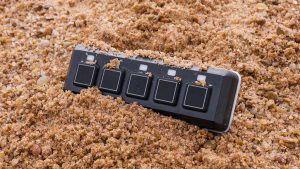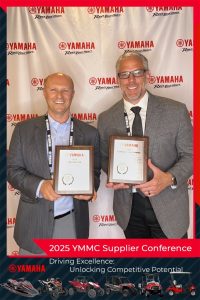
Tier 4 is the new Emission regulation for non-road diesel engines set forth by the Environmental Protection Agency. This regulation will reduce the amount of Particulate Matter exhausted by a diesel engine by 95%. Likewise, Nitrogen oxides, otherwise known as NOx, will be reduced by 90%, and sulfur oxides will be virtually eliminated from the exhaust gasses.

The EPA states that the removal of these harmful gasses from the exhaust of diesel engines will benefit the health of US citizens. New low sulfur fuels lend themselves to using catalytic substrates on the new tier 4 engines. Tier 4 regulations will be implemented in a phased, two step approach due to the vast reduction in harmful gasses compared to the tier 3 standards. It is a large enough change that the EPA did not feel manufacturers could satisfy the requirements at one time.
Interim Tier 4 is the first step in the regulation that reduces Particulate Matter by 90% over Tier 3 Emission standards. Likewise, there is a 50% reduction in NOx over Tier 3. Interim Tier 4 began implementation on small horsepower platforms in 2008. The next step in the Tier 4 regulation is Tier 4 Final. This final regulation implements an 80% reduction in NOx over Interim Tier 4. Depending on engine size, Final Tier 4 will go into effect starting in 2012.
Stage III/IV is the European Union Emissions Standard for diesel engines in particular kilowatt ranges. These emission regulations are the European Union’s equivalent to the United States EPA Tier 4 Interim standard.
Diesel Particulate Filter
A device often referenced as DPF that is used to filter diesel particulates out of exhaust in diesel engines. When this is becoming clogged due to the engine’s load not passively burning the soot, the engine will send out a message on the SAE J1939 CAN bus using PGN 64892 SPN3697 with an ON, OFF, or BLINK of the icon depending on the state of filter and engine. This usually indicates a regeneration of the engines exhaust is needed to actively heat and burn the soot from the DPF. Refer to engine manufacturer for further detail.
Selective Catalyst Reduction
This is often referenced as SCR. There are 4 major components of this system. The components are:
- Diesel Exhaust Fluid (DEF) tank/Catalyst Tank
- a DEF doser
- SCR Catalyst
- an ammonia Catalyst.
This works by injecting a small amount of Diesel Exhaust Fluid (DEF) into the catalyst where it is mixed, and reacts to the NOx found in the exhaust to produce nitrogen gas and water vapor that is released through the exhaust in a safe environmental method.
Tier 4 Interim/Euro Stage III/IV Support on PowerView
Regeneration is the burning of soot from the Diesel Particulate Filter. There is a passive regen where the exhaust gasses are hot enough to burn the soot out of the filter under standard operation. This regen takes place under normal operating conditions that become transparent to the user. There is also an active regen that requires the introduction of a secondary heat source to burn the soot from the Diesel Particulate Filter. The Active Regen takes place when the exhaust gas temperature is too low to achieve regeneration of the DPF. Due to the low temperature, a secondary heat source must be provided to clean the filter of soot. This can be done in a variety of ways including dosing, exhaust stroke fuel injection, or the use of a secondary heating element. Dosing is a process that injects diesel fuel into the diesel particulate filter to burn off the soot. Another method is injecting diesel into the combustion chamber during the exhaust stroke also pushes raw, burning fuel into the DPF for cleaning. Lastly, some manufactures are using a heating element in the DPF to burn the soot load.
Regeneration Options
PowerView offers three CAN-enabled options to choose if this is enabled and allowed in the engines ECU.
- AUTO DPF REGEN – This option is the factory default. When this option is selected PowerView sends a CAN message to the ECU to perform a DPF Regeneration automatically when needed.
- REQUEST DPF REGEN – This option is used when either the engine is not to the point for an auto regeneration to take place or when the engine regeneration is inhibited via PowerView. The PowerView sends a request for regeneration via CAN message to the ECU. This message is sent every second for 10 seconds. If the engine does not respond within this timeframe, the PowerView will default back to Auto DPF Regen.
- INHIBIT DPF REGEN – This option is used when the application cannot perform an active regeneration due to certain restrictions. This option sends an inhibit message via CAN to the engine ECU to eliminate the possibility of an active regeneration. When the ECU accepts the message it will send an inhibited message and the inhibit Icon displays on the screen. Once the Inhibit DPF Regen is selected it will remain selected through power cycles and will need to be changed if inhibit is not needed any longer.
Regeneration/SCR Parameters
- Catalyst Tank Level “Diesel Exhaust Fluid Level” (DEF LVL) – PGN 65110 SPN 1761
- Diesel Particulate Filter 1 Soot Load Percent (% SOOT) – PGN 64891 SPN 3719
- Diesel Particulate Filter 1 Ash Load Percent (% ASH) – PGN 64891 SPN 3720
- Aftertreatment 1 Diesel Particulate Filter Outlet Temperature (EF OUT T) – PGN 64947 SPN 3246
- Aftertreatment 1 Diesel Particulate Filter Inlet Temperature (EF IN T) – PGN 64948 SPN 3242



